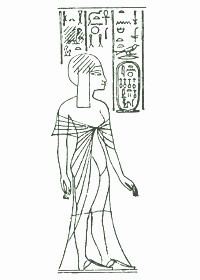Name Mutnedjmet Mutnedjmet Egyptian name Father possibly Ay Parents Tey, Ay | Children Tanedyemy Grandparents Tjuyu, Yuya | |
 | ||
Cousins Akhenaten, The Younger, Sitamun, Thutmose, Beketaten Similar People Horemheb, Ay, Tey, Ankhesenamun, Tiye | ||
Mutnedjmet (Mutnedjemet, Mutnodjmet, Mutnodjemet) an Ancient Egyptian queen, the Great Royal Wife of Horemheb, the last ruler of the Eighteenth Dynasty. The name, Mutnedjmet, translates as: The sweet Mut.
Contents
- Titles
- Mutnedjmet as Nefertitis Sister
- Monuments and Inscriptions
- Death and Burial
- In popular culture
- References

Titles
Mutnedjemet's titles include: Hereditary Princess (iryt-p`t), Great King’s Wife (hmt-niswt-wrt), Great of Praises (wrt-hzwt), Lady of Grace (nbt-im3t), Sweet of Love (bnrt-mrwt), Mistress of Upper and Lower Egypt (hnwt-Shm’w -mhw), Songstress of Hathor (hsyt-nt-hwt-hrw), and Songstress of Amun (Sm’yt-nt-imnw)
Mutnedjmet as Nefertiti's Sister
Some Egyptologists have speculated that Mutnedjemet is identical to Nefertiti's sister Mutbenret. This identification was partially based on the fact that Mutbenret's name used to be read as Mutnedjmet. Other Egyptologist such as Geoffrey Martin note that there is no definite evidence to prove this assertion. Martin writes that:
The name Mutnodjmet was not particularly rare in the late Eighteenth Dynasty, and even if she were the sister of Nefertiti her marriage to Horemheb would have had no effect on Horemheb's legitimacy or candidacy since Mutnodjmet (who is depicted in the private tombs at El-Amarna) was not herself of royal blood. In any case whatever her antecedents Mutnodjmet could have been married to Horemheb a little before he became Pharaoh.Monuments and Inscriptions
Mutnedjmet is known from several object and inscriptions:
Death and Burial
Mutnedjmet died soon after Year 13 of her husband's rule in her mid-40s based on a wine-jar docket found in a burial chamber of Horemheb tomb at Saqqara, in Memphis and a statue and other items of hers found here. The mummy was found in King Horemheb's unused Memphite tomb along with the mummy of a still-born, premature infant. She appears to have been buried in the Memphite tomb of Horemheb, alongside his first wife Amenia. Mutnedjmet's mummy shows she had given birth several times, but the last King of the 18th dynasty did not have a living heir at the time of his demise. It has been suggested that she had a daughter who was simply not mentioned on any monuments. The presence of the infant along with Mutnedjmet in the tomb suggests that this queen died in childbirth. A canopic jar of the Queen is now located in the British Museum.
It is possible that the tomb QV33 in the Valley of the Queens was originally built for her. The tomb is known as the tomb of an otherwise unknown Tanedjmet, but both cartouches with her name are damaged and the similar hieroglyphs for ta and mut allow for this interpretation.
